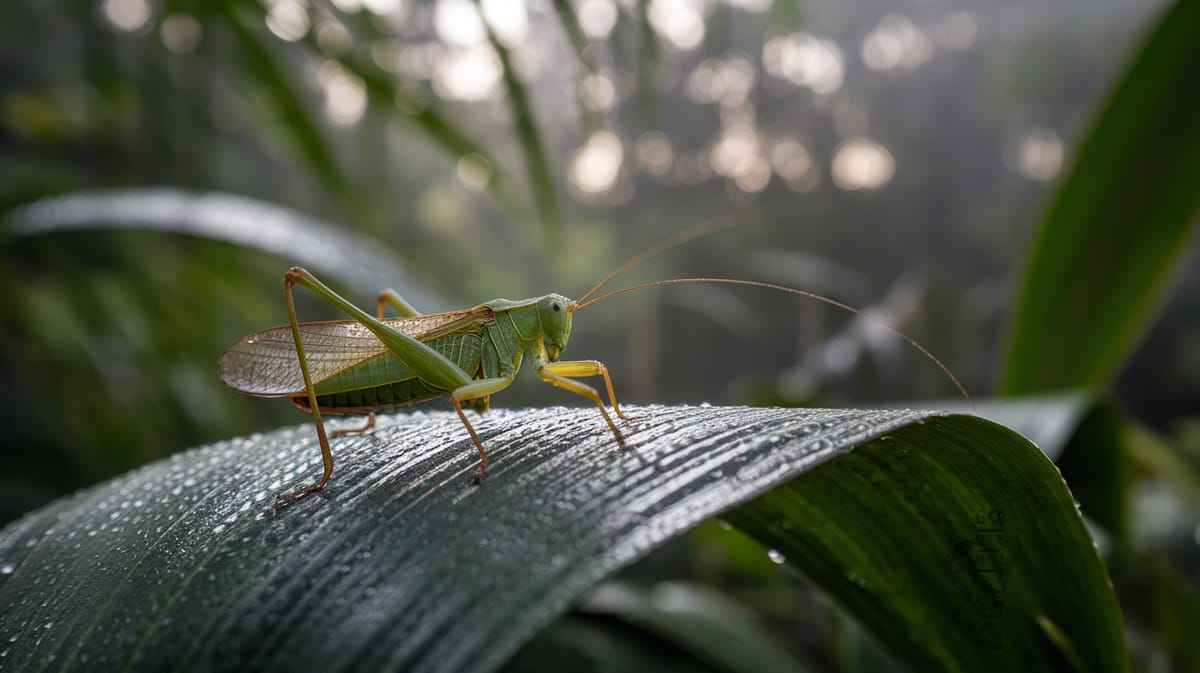Katydid
Whispering through the night, the Katydid mimics leaves to evade predators while emitting melodic calls. This insect plays a crucial role in balancing ecosystems by controlling plant populations.

Gallery






Key Insights at a Glance
Did You Know?
Taxonomy & Classification
Katydids boast exceptional camouflage abilities with leaf-like wings, aiding their survival as herbivorous insects in varied environments. Let's understand the evolutionary journey and classification of these remarkable herbivores.
Global Distribution
Katydids encompass over 6,400 species across every continent except Antarctica, highlighting their vast adaptability and ecological presence.
Evolutionary Heritage
Originating in the Triassic period, katydids have evolved impressive acoustic communication abilities for mating and territory defense.
Lifecycle and Growth
A remarkable journey of transformation from Egg to Adult.
Egg
Katydid eggs are deposited in soil or plant tissues, where they remain dormant through cooler months before hatching.
Nymph
Nymphs resemble small adults but lack wings, undergoing 5-10 molts as they grow and develop their adult features.
Adult
Mature adults have fully developed wings and engage in nocturnal mating calls, contributing to the next generation.
Dietary Habits
A proficient herbivore and occasional predator, this insect primarily feeds on leaves but can consume smaller insects when necessary.
| DIET TYPE | DESCRIPTION |
|---|---|
| Primary Diet | Consumes leaves, flowers, and stems of various plants, making it primarily herbivorous. |
| Secondary Diet | Occasionally eats caterpillars and smaller insects, supplementing its plant-based diet with protein-rich prey. |
| Occasional | Rarely ingests seeds and fruits, showcasing adaptability in times of food scarcity or environmental changes. |

Behaviour and Adaptations
Discover the remarkable adaptations that enable the Katydid to thrive in its environment.
Leaf Mimicry
Perfectly imitates leaves to evade predators and remain undetected.
Acoustic Communication
Uses sound to attract mates and establish territory.
Hind Leg Jumping
Capable of powerful leaps to escape threats and navigate terrain.
Ecosystem Impact
Katydids play a vital role in maintaining ecological balance through their diverse contributions.
Natural Pest Control
Katydids help control pest populations by feeding on harmful insects.
Food Source
They are a crucial food source for birds and other predators.
Plant Pollinators
Katydids contribute to the pollination of various plants during their feeding activities.
Conservation Challenges
Understanding and addressing the major threats to Katydid populations.
Habitat Loss
Urban development and agriculture reduce katydid habitats significantly.
Climate Change
Altered weather patterns disrupt breeding and food sources for katydids.
Pesticide Use
Chemical pesticides threaten katydid populations directly and indirectly.
Frequently Asked Questions
How long do Katydid live?
Katydids typically live for about a year. Their life cycle includes egg, nymph, and adult stages, with adults usually seen during late summer and fall. Environmental factors, such as climate and predation, can influence their lifespan.
What do Katydid eat?
Katydids primarily feed on leaves, flowers, and stems of various plants. Some species may also consume small insects. They are mostly herbivorous, using their strong mandibles to chew plant material.
Are Katydid poisonous?
Katydids are not poisonous to humans or pets. They do not produce venom or toxins. Their primary defense mechanisms include camouflage and nocturnal behavior to avoid predators.
Are Katydid endangered?
Most katydid species are not endangered. However, habitat loss and environmental changes can threaten some local populations. Conservation efforts are crucial to preserve their natural habitats and biodiversity.
What do Katydid symbolize?
Katydids often symbolize intuition, sensitivity, and the ability to listen. In some cultures, they represent good luck and are associated with the renewal of life, especially due to their connection with the changing seasons.
Do Katydid bite?
Katydids have the capability to bite humans, but it is rare and not harmful. Their bites are not venomous and typically occur only if they feel threatened or mishandled.
What color are Katydid?
Katydids are usually green, which helps them blend into their leafy surroundings. Some species may also exhibit brown or pink hues, providing camouflage in different environments. Their coloration is an adaptive trait for survival.
Does a Katydid have wings?
Yes, katydids have wings. Adult katydids possess long wings that they use for flying and creating their distinctive mating calls. The wings also aid in camouflage, mimicking leaves when at rest.
What does a Katydid look like?
Katydids resemble grasshoppers but have longer antennae and leaf-like wings. They are typically green, aiding in their camouflage among foliage. Their bodies are elongated, and they have strong hind legs for jumping.
Is a Katydid an insect?
Yes, a katydid is an insect. It belongs to the order Orthoptera, which also includes grasshoppers and crickets. Katydids are characterized by their long antennae, powerful legs, and ability to produce sound.
Related Insects
Discover insects with similar characteristics to Katydid - including shared habitats, diets, and taxonomic classifications